May 4, 2007
Air Date: May 4, 2007
FULL SHOW
SEGMENTS
Climate Solutions
View the page for this story
Representatives from over 150 countries from around the world recently met in Bangkok to hash out details of the fourth report from the Intergovernmental Panel on Climate Change. The report offers solutions to tackle human-induced global warming--everything from increasing efficiency to reducing our dependency on fossil fuels. Living on Earth host Steve Curwood speaks with Bill Moomaw, who served as lead author on the third IPCC report. (10:00)
Emerging Science Note/Narwhals Track Climate Change
/ Meghan VigeantView the page for this story
Researchers are looking to small whales called narwhals for information about climate change. Meghan Vigeant reports. (01:45)
Southwest Water Woes
/ Brian MannView the page for this story
There’s been a drought in the Southwestern U.S. since 1998, but that hasn’t stopped the population in the region from rising by a million people per year. Brian Mann reports on the Colorado River’s struggle to meet growing water demands in the Southwest. (07:30)
A Year of Eating Locally
View the page for this story
Author Barbara Kingsolver recounts her experience of eating locally grown food for a year in the new book “Animal, Vegetable, Miracle: A Year of Food Life.” She tells host Steve Curwood about why food has become a political and environmental issue, about the challenges involved with finding a variety of local food year-round, and how the commitment ultimately changed her family’s life for the better. (09:30)
Zambian Goldman Prize Winner
View the page for this story
Hammerskjoeld Simwinga of Zambia won this year’s Goldman Environmental Prize for Africa. Simwinga works to promote community development and wildlife conservation in the North Luangwa Park region of his country. He tells host Steve Curwood about the challenges he's faced and his plans for the future. (15:45)
This week's EarthEar selection
listen /
download
To infinity and beyond! Sounds from the "golden record" sent into space thirty years ago on NASA's Voyager.
Show Credits and Funders
Show Transcript
HOST: Steve Curwood
GUEST: William Moomaw, Barbara Kingsolver, Hammerskjoeld Simwinga
REPORTER: Briann Mann
SCIENCE NOTE: Meghan Vigeant
[THEME]
CURWOOD: From Public Radio International - this is Living on Earth.
[THEME]
CURWOOD: I’m Steve Curwood. How much global warming is too much? The latest scientific assessment from the UN offers a range of choices for reducing emissions, but the scientists leave it up to governments to decide what’s to be done.
MOOMAW: The right target is actually- that’s really a political decision not a scientific one. I mean, how much pain we're willing to tolerate is going to be a political decision.
CURWOOD: Also biologist-turned-best-selling novelist Barbara Kingsolver tells the tale of her family’s commitment to eat mostly local food for an entire year.
KINGSOLVER: As happened over and over again in this project what we found was so much more than what we were looking for. This isn’t a story of deprivation. This is a story of gratitude.
CURWOOD: Barbara Kingsolver and Animal, Vegetable, Miracle and more this week on Living on Earth. Stick around!
[NPR NEWS CAST]
[Boards of Canada “Zoetrope” from ‘In A Beautiful Place Out in the Country’ (Warp Records – 2000)
ANNOUNCER: Support for Living on Earth comes from the National Science Foundation and Stonyfield Farm.
[THEME]
Climate Solutions
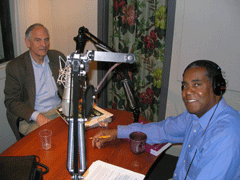
Professor Moomaw joins Steve Curwood in the Living on Earth studio. (Photo: Ian Gray)
CURWOOD: From the Jennifer and Ted Stanley Studios in Somerville, Massachusetts - this is Living on Earth. I’m Steve Curwood. Every five or six years since 1990 the United Nations has pulled together a panel of more than a thousand scientists from around the world to assess the state of global warming. After marathon meetings this past week in Bangkok to thrash out a summary, the Intergovernmental Panel on Climate Change has just issued the third and final part of its 2007 assessment.
The first two sections looked at basic science and the coping abilities of civilization and nature in the face of impacts ranging from storms and rising sea levels to severe drought and vanishing ice. This final section covers mitigation—things that we could do to slow or halt the warming. Bill Moomaw is a chemist and a professor of international environmental policy at Tufts University. He is one of the key authors of the mitigation report and joins us now. Hello sir.
MOOMAW: Hello, thank you for having me.
CURWOOD: So give me the basics here on mitigation. We’ve heard the science of climate change. We heard about how the planet can adapt to all this, what’s going to happen to people. And now we’re focusing on mitigation, that is what could be done to stop this process before it becomes inevitable. Why is this the most controversial?
MOOMAW: I think it’s the most controversial because it gets closest to questions of economics and policy. And therefore, first of all, if you think about the science even though there’s been a little fuss over the science it’s much easier to demonstrate whether the science is right or not by doing another measurement going out and doing another experiment. The greatest uncertainty is not in how climate will change, the greatest uncertainty is what we’ll do about it and whatever actions we take what their impact will be.
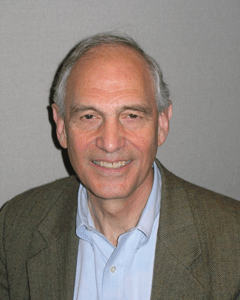
Professor Bill Moomaw (Photo: Ian Gray)
CURWOOD: Now the basis of this report was already written quite some time ago. What was all in contention in these last few days leading up to the final release of the report?
MOOMAW: What’s really in contention here is the language, how things are stated and which items are emphasized. The interesting thing about the summary for policy makers which was debated in Bangkok is this is the only piece that the governments have control over. This is their document. The draft is prepared by technical people but then it’s really their document. So for example China wanted to be sure there was a statement in there that developed countries were responsible for the majority of heat-trapping gasses in the atmosphere. That apparently went through fairly easily because it’s true. You know you turn to the technical people and say, “is this true?” And the answer is, “yes it’s true.” So we can put that in.
There may be some things more contentious. Some countries may not want to see as strong a statement about nuclear power because they’re worried about nuclear proliferation or something of that sort. So they’ll want to maybe tone down what they see as too strong a statement. In order for it to get into the summary for policy makers though the technical people, those of us who toil in the trenches on this, who are there in Bangkok have to agree that it is consistent with the underlying science and analysis that’s in the report.
CURWOOD: I’m looking at the summary for policy makers from this and I see a variety of targets that are set for where we need to maintain a stable emissions if we want to avert some of the catastrophes that have been predicted by a rapid climate change in which are referred to in some of the other parts of the Intergovernmental Panel on Climate Change report. What’s the right target here?
MOOMAW: Well, the right target is actually, that is really a political decision and not a scientific one. I mean how much pain we’re willing to tolerate is going to be a political decision. We’re going to say governments are going to decide individually and collectively on a target. What we do is say, “ok, what happens if we go from our current level of say 380 parts per million of carbon dioxide plus 100 parts per million equivalent of other gases up to 650 parts per million. And what would it cost to hold it at or below that level by the year 2100?” And then we do the same thing for 550 and 450 and so forth. Now in the previous report the lowest analysis that was done was for 550 parts per million which is a lot. It’s about double pre-industrial levels. The reason that was in there was because the economists all said, “oh it will be too costly to do anything more than that, any greater reductions than that.” The science that has come in since then suggests that 550 would be pretty devastating. And the cost of damage would be higher than were estimated in the 2001 report.

Professor Moomaw joins Steve Curwood in the Living on Earth studio. (Photo: Ian Gray)
MOOMAW: At 450 we’re on the edge. And 450 is interesting. The way these are done, because there are all kinds of still some uncertainties, the 450 number says the way these probabilities are calculated that means there’s a one chance in two, 50 percent probability, that the temperature would rise by less than four degrees Fahrenheit.
CURWOOD: So 50-50 would be able to keep the planet the way we sort of have it?
MOOMAW: It would be recognizable. It would still be recognizable.
CURWOOD: At 550 and 650 parts per million the earth would not be recognizable?
MOOMAW: I think certainly the natural systems around us have changed dramatically. The agricultural systems are severely changed and in areas like Africa, devastation.
CURWOOD: So what kind of solutions are necessary to implement the goal of keeping global CO2 equivalent emission below 450 parts per million and what does the report say?
MOOMAW: Ok. What the report says is that there are three basic things that have to be done. We have to use the energy that we’re using much more efficiently. And then it goes through literally hundreds of things that can be done in buildings and industry and electric power generation and agriculture and just every aspect of our lives. That is the first thing. It’s the cheapest thing to do. We also, by the way, this report looks not only at the levels in the technologies and the strategies and the policies that might get us there but it looks at the potential costs. So there are cost figures in there.
Secondly, if we really are serious about staying down at 450 in addition to all the efficiency gains- which are substantial- we have to go to some zero emitting electric power generation sources. And that means taking a very strong look at nuclear power and all the renewables: wind and solar and geothermal and all those things, biomass done right, which is a very important caveat.
And the final thing is looked at is if we’re going to continue using coal and natural gas we need to capture the carbon dioxide and store it under ground or possibly in the oceans although that has some other issues associated with it.
CURWOOD: So what are the most promising technologies out there that aren’t being currently used on a large-scale commercial basis?
MOOMAW: Well, certainly from the point of view of efficiency the low hanging fruit is buildings. Buildings use vastly more energy than they need to. I’m actually building a home right now which uses 1/5 the energy of a new code-built house in Massachusetts to begin with. It’s doable. It’s affordable and we just need to get on with doing it.
CURWOOD: So, how do the reports issued by the IPCC help put pressure on policy makers?
MOOMAW: It’s very interesting. The first report came out in 1990 and in 1992 there was the UN framework convention on climate change that was adopted by the nations of the world and George Bush the first signed it and brought it back and had it ratified by the Senate. The 1995 report was issued and in 1997 the Kyoto Protocol was enacted. In 2001 the third report came out and that put pressure on a number of countries to ratify the Kyoto Protocol, which finally was successfully done when Russia ratified even though the United States did not.
CURWOOD: And now this fourth report?
MOOMAW: And now this fourth report comes at an opportune time because under the Kyoto Protocol this is the year, 2007, when we must begin negotiating what happens after 2012 when the Kyoto Protocol comes to an end. And so this is laying out for governments: What do we know about the science? How bad is climate change? How bad is it going to get? What are the impacts? What adaptation needs to be done? And what are the mitigation options that are available to us?
CURWOOD: Bill Moomaw is professor of international environmental policy and directs the Center for International Environment and Resource Policy at Tufts University. Thank you so much sir.
MOOMAW: Thank you for having me.
[MUSIC: Max Richter “Organum” from ‘The Blue Notebooks’ (Fat Cat Records – 2004)]
CURWOOD: You can find a link to the full report from the Intergovernmental Panel on Climate Change on our website, loe.org. Some advocates say one way to cut emissions without cutting up the economy is to ask the marketplace to find the cheapest options.
Next week, we’ll take a look at the brisk trading of carbon emission rights now underway in Europe.
REDSHAW: For example, we’ve worked with a Scandinavian paper mill. As they’ve made themselves more efficient, they’ve got emissions credits left to sell. And we’ve sold those to a UK utility, which has found that with the high gas prices they want to burn more coal. And as a consequence, we’ve put together two people who wouldn’t ordinarily speak to each other. Because a UK utility is not going to be talking to Scandinavian paper mills.
CURWOOD: Europe trades carbon, next week on Living on Earth. Right now here’s this weeks note on emerging science from Megan Vigeant.
Related link:
Intergovernmental Panel on Climate Change
Emerging Science Note/Narwhals Track Climate Change
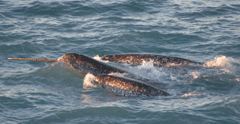
Narwhals swimming in Baffin Bay (off the coast of Greenland). (Photo: Kristin Laidre/Polar Science Center/APL/University of Washington)
[NARWHALS]
VIGEANT: A Cracker Jack team of researchers has been at work this winter bravely diving and swimming in the chilly arctic waters between northern Canada and Greenland.
[THEME]
VIGEANT: The divers have been gathering data beneath the ice of Baffin Bay. You can spot them when they surface by their unusual tusks. Oh, that’s right, these novice oceanographers are actually narwhals, sometimes known as the “unicorn of the sea.”
The single, long, spiraled tooth growing from a male narwhal’s upper lip was likely the origin of the myth of the unicorn. Fairy-tales aside, now these narwhals are getting the facts.

Narwhals swimming in Baffin Bay (off the coast of Greenland). (Photo: Kristin Laidre/Polar Science Center/APL/University of Washington)
The data Leidre and the narwhals are collecting may help climatologists answer big questions about what’s going on as the region warms and more ice melts. The narwhals winter home of Baffin Bay is tied to the Gulf Stream, a major influence on the climate of North America and Europe. But the bay’s dense winter ice cover has made it difficult for scientists to get temperature data. Now, with the help of nature’s legendary unicorn of the sea, the picture may become clearer.
And that’s no fairy tale.
[THEME]
CURWOOD: And you’re listening to Living on Earth
[MUSIC: Jake Shimabukuro “Heartbeat/Dragon” from ‘Gently Weeps’ (Hitchhike Records - 2006)]
Southwest Water Woes
CURWOOD: It’s Living on Earth. I’m Steve Curwood. Every day, it seems, thousands of Americans pack up for the sunny skies of the Southwest, especially the booming cities of Las Vegas and Phoenix. The Southwest is a desert, of course, but thanks to the massive water projects of the 1930’s it became hospitable for millions of settlers. But now there’s trouble in the Southwest. The region is suffering through its eighth year of drought with little or no relief in sight. For much of its water the Southwest relies on the Colorado River to brings snowmelt from the Rocky Mountains. But snow patterns are changing and the Colorado is carrying a lot less water than it did a century ago. Overall it seems global warming is hitting the region harder than just about anywhere else in the country
Brian Mann of North Country Public Radio has our story.
DOCUMENTARY AUDIO: Here's where man conquered this mighty river, placing a concrete yoke about its neck.
MANN: This is Hoover Dam on the Nevada-Arizona border. In 1935, Franklin Roosevelt dedicated the massive, gleaming structure, harnessing the Colorado River.
DOCUMENTARY AUDIO: This great achievement of American resourcefulness, American skill and American determination. Hoover Dam brought the desert flood control, a reliable supply of water, electrical power, and more.
MANN: Seventy-five years later, big crowds of tourists squeeze through the dam's visitor center.
ANNOUNCER: Come on in, folks, Find a place where you can see!
MANN: This may be one of the world's modern engineering marvels. But tour guide Bruce Laughlin, who works for the Federal Bureau of Reclamation, acknowledges that the Colorado River's great reservoirs -- at Lake Powell and here at Lake Mead -- were built for much wetter times. For nearly a decade, they've been drying up.
LAUGHLIN: I think we're about 54%.
TOURIST: How long since it's been full?
LAUGHLIN: This lake was filled right to the top before this drought started in 1998. This coming year, they're going to hold as much water as they can in the upper lake because they need to fill up Lake Powell, because it's getting dangerously low. This lake’s probably gonna go down more.
MANN: Scientists now believe that the West was settled during an unusually wet period. The people who built these reservoirs had unrealistic expectations for how much rain and snow would fall each year. Recent climate models predict further drying, less precipitation for the Southwest.
GLEICK: If nature gives us a little less water, then there just is not enough to go around.
MANN: Peter Gleick is a water expert at an environment and resources think tank in Oakland, California called the Pacific Institute.
GLEICK: It turns out that a very small decrease in average flow of the Colorado, in the long run, drains those reservoirs dry.
MANN: A new study by the Lamont-Doherty Earth Observatory at Columbia University -- published in the journal Science -- focused on predictions for the Southwest. Atmospheric scientist and lead researcher Richard Seager says he expects precipitation in the region to drop by 10-20 percent before mid-century. Meanwhile the population of the Southwest is still growing by roughly a million people a year.
SEAGER: With declining water availability there's going to be quite a tussle about who gets the water and whether it's going to be possible to reallocate water in a way that will retain agriculture that's needed, but also sustain a growing urban population.
MANN: Rising temperatures are already shrinking the mountain snow pack, which feeds Western rivers through the summer. In the future, by summer's end, there may be no more snow to melt.
SEAGER: So that natural system of water storage that the water supply system is relying on is going to become less effective.
MANN: Water experts say these incremental changes could disrupt the Colorado River's complicated system of dams, reservoirs and allocation treaties that now supply water to 25 million people.
MULROY: What resources we do have, given what global warming could present to us, could evaporate tomorrow.
MANN: Patricia Mulroy is general manager of the Southern Nevada Water Authority, which is charged with supplying water to the city of Las Vegas.
MULROY: I do believe that the Colorado River is going to be severely challenged as we go through global warming. We're already behind in developing those alternatives on how to protect human existence in the West.
MANN: Conservation is a necessity. And some fast-growing cities have implemented water-use restrictions unheard of in water-rich parts of the U.S. Denver and Aurora, Colorado are seen as models -- as is Tucson, Arizona. Here in Las Vegas, there are actually water detectives, who sniff out waste.
NICHOLAS: Here's the trail of water coming from somewhere up the street here, we'll follow it to its source hopefully.
REPORTER: Pretty good clue trail to follow right there.
MANN: Midmorning, Ken Nicholas, a water cop with the Las Vegas Valley Water District, is patrolling an upscale Vegas neighborhood.
[CAR DOOR SHUTS]
MANN: Nicholas pulls over and talks with a woman outside a suburban ranch house. With its water-hungry lawn and thirsty mulberry trees, this could be a home in Buffalo or Chicago.
NICHOLAS: You have nozzles by the mailbox that are spraying into the street.
WOMAN: I don't live here, I'm just the nanny.
MANN: The Water Authority has combined this kind of enforcement with new incentives, urging people to convert from grass and shrubs to desert plants and rock gardens. But critics say the city isn't doing nearly enough. Down on Vegas's casino strip, there is water everywhere -- flowing from extravagant fountains, gushing over manmade waterfalls.
[WATER SOUNDS]
MANN: Outside the Venetian, one of Vegas's showcase casinos, gondolas ferry tourists through glittering canals. This water is re-circulated and reused, but Jill Rowland-Legan says it's a symbol of the city's outdated thinking.
LEGAN: Are they being smart about growth? Should they have some type of moratorium on growth until we get this water issue taken care of? Are they still catering to the major casinos and the major contractors?
MANN: Jill Rowland-Legan heads the chamber of commerce in Boulder City, a small town that lies between Las Vegas Vegas and the Lake Mead reservoir. Her community has embraced a slow-growth ordinance that limits new home construction.
LEGAN: We don't even take our complete allocation of water here in Boulder City because it's all going to Vegas to make sure that they're taken care of.
MANN: But Patricia Mulroy, with the Southern Nevada Water Authority, says slowing Las Vega's growth is not an option. Construction cranes punctuate the horizon. With eight thousand new residents arriving every month, neighborhoods push steadily toward the arid hills.
MULROY: Every piece of private land is acquired with an expectation to not leave it desert, but to build on it. And the private property owner has a right to develop his property.
MANN: Eighty percent of the Colorado River's water is still used for agriculture and Mulroy says that has to change. The Water Authority has already begun buying up farms and ranches in rural Nevada, in a bid to control more water rights.
But as the drought deepens, Columbia University researcher Richard Seager says rain and snowfall in this region will decline to levels not experienced since the Dust Bowl of the 1930s. Only this time, the dry spell won't end.
SEAGER: That level of reduction was enough to cause really severe trouble and that level of reduction persisting for an even longer period of time will equally cause a lot of trouble.
For Living On Earth I'm Brian Mann in Las Vegas, Nevada.
[MUSIC: Peter Rehberg “TT 1205” from ‘Touch 25” (Touch – 2006)]
A Year of Eating Locally
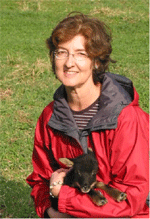
Barbara Kingsolver and a lamb born on her Virginia farm. (Courtesy of Barbara Kingsolver)
CURWOOD: Barbara Kingsolver left life in the farm country of Kentucky in the 1970s to become educated as an evolutionary biologist. But what she didn’t know was that she would also become a best-selling novelist. You may know some of her titles: The Poisonwood Bible is one, Prodigal Summer is another. Now she and her husband and daughter have a volume that documents how her family carried out a vow to eat only locally grown food for one year.
The book is called Animal, Vegetable, Miracle; A Year of Food Life. Her family produced about seventy percent of what went on their table from their own farm in Virginia—everything from tomatoes to turkeys. What they couldn’t grow they mostly bought from local farmers. I spoke with Barbara Kingsolver recently. I asked her what motivated her and her family to become what’s known as locavores—people who eat locally.
KINGSOLVER: We were led into this project for so many reasons. For me, It’s because I grew up in a rural community among farmers and I’ve always considered the local farming economy to be important and frankly an important part of food security. We are now, as a nation, putting almost as much fossil fuels into our refrigerators as our cars. Every item on average on the American plate has traveled 1500 miles so add up all the items on your plate and you might as well order room service from the moon!
That’s an incredible amount of fossil fuel, an incredible amount of carbon emissions going into the atmosphere, warming up the globe just to get a grape from Chile, a tomato from Mexico so I can eat a tomato in January.
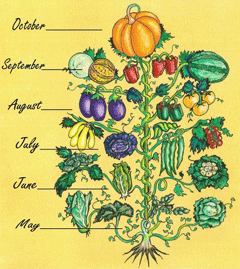
The “vegetannual,” a term invented by Barbara Kingsolver to describe when fruits and vegetables are in season. (Courtesy of Barbara Kingsolver)
KINGSOLVER: I’m so glad you brought that up. US tax payers pay tens of billions of dollars every year to subsidize the production of commodity crops which are, as you mentioned, mostly corn wheat and soybeans. Most of that production enters our diets without our notice as the ingredients of processed foods like high fructose corn syrup and feed to raise cattle and hogs. And we also as taxpayers subsidize the fuel costs of getting these products manufactured and shipped to the market. So it’s a funny thing in this country we think of fast food as cheap in spite of all the fossil fuels and processing that were required to make it while we think of simple unprocessed organic produce as sort of elite, an expensive option. It’s incredibly ironic that the US government urges us to eat more fruits and vegetables but our agricultural programs offer virtually no assistance to fruit and vegetable growers.
CURWOOD: About what did it cost you to grow your own food and buy the rest of it locally?
KINGSOLVER: You know what, we were stunned by the answer to that question. I kept really careful records and I found out that we spent about 50 cents per person per meal to eat as splendidly as we did in this year. And I thought this must be a mistake so I went back and I recalculated and that was it: 50 cents per person per meal.
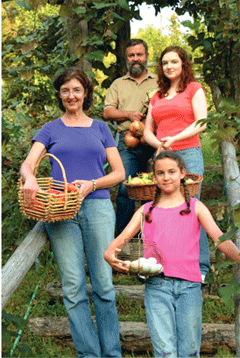
Barbara Kingsolver and family. (Photo: Hank Daniel)
KINGSOLVER: You start by accepting this will be a paradigm shift. This will be a change in the way you think about food and as time went by we really learned to stop asking the question, what do I want right now? and instead start seeing each week as something like the menu in a restaurant Look at what’s available. What do they have? What’s growing this week? What’s fresh and delicious and choose from that.
I do want to point out that we weren’t the strictest locavores. We didn’t for example give up coffee because my husband said, “Coffee will get you through times with no food better than food will get you through times with no coffee.” And I began to understand important things about my marriage.
CURWOOD: Now you were a vegetarian for many years but as part of this project you decided to raise and slaughter your own meat. Talk to me about how and why you came to that decision.
KINGSOLVER: It’s really important to know that food is not just a product but a process. There are two very different ways of producing meat. One of them is concentrated animal feeding operations or CAFOs. These are feed lots for cattle or metal windowless warehouses for hogs, turkeys, chickens and so forth where they’re crowded as close as they possibly can be and these very concentrated populations require that all of their food be milled and processed somewhere else and brought in and then all of the concentrated waste have to be trucked out to somewhere, heaven only knows where. And these animals get fed this porridge of the cheapest ingredients just for the efficiency of producing cheap meat. And also they have to be given antibiotics in order to keep them alive under conditions of extreme physiological stress. So that kind of meat I hadn’t eaten for many years.
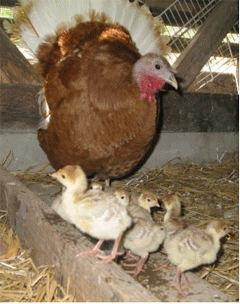
This breeding flock of Bourbon Red turkeys is one of the last remaining flocks in the world.(Courtesy of Barbara Kingsolver)
CURWOOD: Now, there’s a great scene in your book when you’re getting ready to have a party in the early spring. Around this time of year.
KINGSOLVER: That’s right, in May.
CURWOOD: Around your birthday I guess.
KINGSOLVER: Yeah.
CURWOOD: And you’d only been at this a little while. I mean you didn’t have last year’s canned goods or anything stuck in your freezer that you could trot out here.
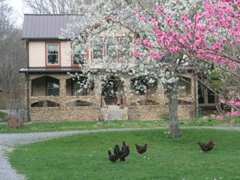
The farmhouse in Virginia. (Courtesy of Barbara Kingsolver)
CURWOOD: Now, where you are in Virginia, you’ve got a farm, a lot of neighbors who are in the food business. But what about somebody who lives in say the city or say a colder climate. What kind of advice would you offer for taking steps to eat more locally?
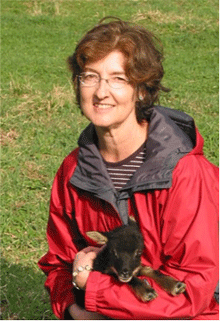
Barbara Kingsolver and a lamb born on her Virginia farm. (Courtesy of Barbara Kingsolver)
CURWOOD: So you eat locally for a year and you lived to tell about it and the day this project was finished did you run out for what uh maybe uh…
KINGSOLVER: Coca Cola and moon pies? No, we didn’t. We forgot to notice the day the project ended. By this time it was just the way we lived. We have a new relationship with where we live. We are what we ate.
CURWOOD: Barbara Kingsolver’s new book is Animal, Vegetable, Miracle; a Year of Food Life. It was written with her husband Steven L. Hopp and daughter Camille Kingsolver. Barbara, thank you so much.
KINGSOLVER: Thank you, bye.
CURWOOD: You can hear more of our conversation with Barbara Kingsolver, as well as readings from the new book and some of her family’s favorite home-grown recipes at our website, loe dot org.
Related links:
- For recipes and a tour of the farm click here
- Barbara Kingsolver’s website
- The Farm Bill is up for renewal. Click here for more information
- USDA Farm Bill Website
- To find community supported agriculture in your area click here
- Edible Communities Website
[MUSIC: Thomas Leeb “Springtime Groove” from ‘Riddle’ (Thomas Leeb – 2005)]
CURWOOD: You can hear our program any time on our website, or get a download for your MP3 player. And of course our website is loe dot org. And your comments are always welcome. Send them to us at comments at loe dot org. Once again, that’s comments at loe dot org. Our postal address is 20 Holland Street, Somerville Massachusetts 02144. And you can call our listener any time at 800-218-9988. That’s 800 218-9988.
CURWOOD: Coming up this year the winner of Goldman Environmental Prize for Africa is a human hammer against poaching and poverty in Zambia.That’s just ahead on Living on Earth.
ANNOUNCER: Support for Living on Earth comes from the Cedar Tree Foundation and from the Richard and Rhoda Goldman Fund; celebrating the 2007 Goldman Environmental Prize winners. Learn more about each winner at www.goldmanprize.org.
This is Living on Earth on PRI, Public Radio International.
[MUSIC: Wise In Time “Nine” from ‘The Ballad of Den The Men’ (Crammed Discs - 2006)]
Zambian Goldman Prize Winner
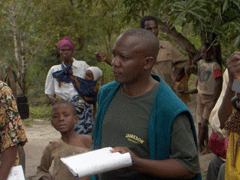
Hammer working with villagers near his home (Photo: John Antonelli/Goldman Environmental Foundation)
CURWOOD: It’s Living on Earth. I’m Steve Curwood. Each year the Goldman Environmental Prize recognizes seven grassroots environmental activists from around the world with prizes of $125,000.This year the winner from Africa comes with a story that may be familiar to listeners to Living on Earth. The tale of Hammerskjoeld Simwinga of Zambia, figures prominently in the book, Secrets of the Savannah. It was written by American zoologists Mark and Delia Owens, who last appeared on our show about a year ago.
They had worked with Mr. Simwinga on elephant conservation and community development in Northern Zambia. The trio helped villagers start a cottage industry pressing cooking oil from sunflowers as an economic alternative for rampant elephant poaching in the area, especially in North Luangwa National Park. Influential commercial poachers and government officials pushed the Owenses out of Zambia a few years ago and Hammerskjoeld Simwinga was left to pick up the pieces. Mr. Simwinga came to the U.S. to receive his Goldman Environmental Prize and joins us now in the studio.
Congratulations!
SIMWINGA: Thank you, thank you.
CURWOOD: How did you get that name, Hammerskjoeld? It doesn’t sound that African to me.
SIMWINGA: No, no it’s Swedish. You know, in the early 60’s we had Dag Hammarskjold who was the Secretary General and he was on a mission to Africa. And sadly he crashed in Ndola, which is our second capital city in Zambia. And by that time dad was working at the nearest hospital and was among the first people to rush to the scene and unfortunately it was a disaster. But a few years later when dad had his first-born he thought of naming him Hammerskjoeld. And that’s how I was named Hammerskjoeld.
CURWOOD: And everybody calls you Hammer.
SIMWINGA: And now everybody calls me Hammer because apparently it is a long name for everybody. And also it’s difficult to write it. The spelling is quite difficult, so I’ve decided to shorten it by Hammer, but I love to be called Hammerskjoeld.
CURWOOD: For the UN Secretary General who was killed in a plane crash there.
SIMWINGA: Yeah, on a noble mission to Africa.
CURWOOD: The very first UN Secretary General I believe.
SIMWINGA: Yeah, he was.
CURWOOD: So, where exactly are you from?
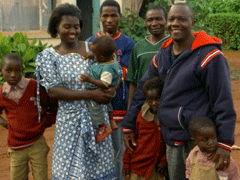
Hammer with his wife and children (Photo: John Antonelli/Goldman Environmental Foundation)
CURWOOD: So, what exactly do you do there?
SIMWINGA: There I’m working with the community because initially this community was more involved in the illegal hunting. And the rate the park was being hunted it was going to maybe by this time sterilized.
CURWOOD: Sterilized, you mean, all the big animals gone?
SIMWINGA: Completely gone. And this is a park, which is about 6,400 kilometers squared. If all big animals were wiped out then this would be just an empty wilderness. I’m also working with the community in terms of providing them with the alternatives. That is in terms of agriculture and cottage industries. This is in terms of promoting bee keeping, fish farming resource.
CURWOOD: So, what inspired you to do this work? If the local business is poaching and illegal hunting why don’t you join with them?
SIMWINGA: Basically it was a sad situation, which maybe inspired me, because at one time we managed to see ten in a day dead elephants with all their tusks gone. And these are creatures, to which to my heart I think it’s our role as human beings to give them the protection. The thing which also made me really inspired and made me really do something was when the herd of an elephant was killed and only the baby elephant remained and had nowhere to go. It started to follow the people wherever they went. So, to me, that really moved my heart and I said we should do something.
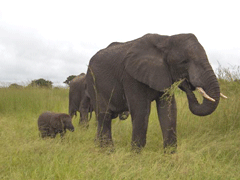
Elephant family in the North Luangwa National Park, Zambia. (Photo: John Antonelli/Goldman Environmental Foundation)
SIMWINGA: Basically, yes, because they were doing their study in the park and their study was constantly disturbed by the heavy poaching which was going on there. Thus when again the thought of maybe increasing the area of intervention. Not only looking into the affairs of the research and the science behind it, but also look at how they can empower the community. So, that’s how they came up with the community development program as another way of saving the national park. So this is where I was hired in, in 1994. To come in and spearhead the community development program. Basically to do more on agricultural development and business entrepreneurship.
CURWOOD: So before you were working on your own dealing with poachers. You were very concerned.
SIMWINGA: Yes, yes.
CURWOOD: And then the Owenses came along and they hired you to help them with their project.
SIMWINGA: Definitely yes.
CURWOOD: So you combine forces.
SIMWINGA: Definitely yes. That was a good team because I found a couple who had the passion for the animals. And also the passion for the country and the passion for the community. So they managed to also raise funds to help the community program by bringing in simple machines like the oil presses. This also helped the community develop bigger interest in preserving the wildlife because now we linked the community program and also the wildlife conservation part of it.
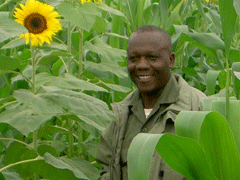
Hammer in a sunflower field (Photo: John Antonelli/Goldman Environmental Foundation)
SIMWINGA: It has never been easy especially conserving wildlife in Africa. Not only in Zambia, but all over Africa because of the poverty levels. And when you try to maybe to stop illegal people doing something wrong then they will ruin your life because you are kind of interfering with their incomes. So definitely it was not only the Mark Owens who were in danger but also the people who were working on the project and also the game scouts who were implementing the law enforcement part. The biggest part was to have the community on our side. And that’s why the community program came in, so that we could offer an alternative so that we could also do ecological management program with them.
CURWOOD: So, what happened? The Owenses they could leave and come back to America. You couldn’t leave. That’s home for you, Zambia.
SIMWINGA: Yeah, it was home so I could not leave. We had a government at that time which was corrupt, of course. But we were quite strong because we stood for conservation. And then that’s how the Mark Owens in fact they were on their holiday here in U.S.A they just heard that their project had been stopped. I had no pay, I had nowhere to go, I had no transport to continue the program. But because of what I said that I was inspired with what was already on the ground I had to stand up because the picture of the baby elephant was still in me. The picture of the community still needing someone to motivate them to go ahead was still in me. They were my people. It is my country. It was my park. I could not come to the United States so I had to remain.

Hammer working with villagers near his home (Photo: John Antonelli/Goldman Environmental Foundation)
CURWOOD: So you founded your own organization then?
SIMWINGA: Yes definitely because I needed to work with something which is legal. Immediately the Owens left, which meant of course the project they were working on ceased to be there. But for me to operate effectively and be protected by the law of the land I had to register an NGO to continue the work. Of course I still maintained the North Luangwa Conservation Project because that was my major strength. And also I still wanted to continue with the community development program. Hence this program has two thrusts: conservation of wildlife and also community development.
CURWOOD: So it’s the North Luangwa Wildlife Conservation and Community Development Program?
SIMWINGA: Yes, which means we have to develop the wildlife and also have to develop the community. So I have to find the balance of the two, which I think we’ve managed to do.
CURWOOD: Of course everyone asks you about this. How safe is for you now? I mean the Owenses were in danger I think people one time, they were looking for you too.
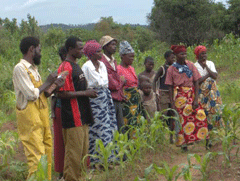
Villagers at an agricultural fair near the North Luangwa National Park, Zambia (Photo: John Antonelli/Goldman Environmental Foundation)
CURWOOD: So, Hammer, where are things now in North Luangwa?
SIMWINGA: I think things are better. Everyone is happy. The community is happy because places where they never used to see an elephant, children who never saw the elephant especially those who were born in the late 80’s, 90’s, they just heard of an elephant. But this time these elephants are moving in their villages. And now we are having a problem on how to control them from raiding their crops. And likely enough and happily enough I’d say we’ve found a kind of simple solution, which has worked for the past three years. We’re using chili- making a chili fence. This is a very humane way, I must say very environmentally friendly way, of protecting the elephants into the people’s fields. The chili is planted either as a boundary to the crop and the other one is we are using pepper chili, you put a small fiber then smear your chili, just a single rope. I mean you cannot imagine that an elephant would be scared to pass through a single rope but that because of the chili, which is a terrible repellent, I don’t know the science behind it but an elephant will never come near a chili plant. And that has worked. And at the moment everyone is growing chili to protect their fields.
CURWOOD: Well, you can imagine, I mean, if you’ve ever had any pepper, sprinkled it out, it makes you sneeze, right?
SIMWINGA: Oh yes, yeah.
CURWOOD: So now you’re an elephant. You know how much nose an elephant has? That’s a lot of nose!
SIMWINGA: Yeah, and the air it takes in!
[BOTH LAUGH]
SIMWINGA: So, I would say the pack is healthy. Both the community and the Zambia wildlife authority and us as a project, we’ve found a better ground to discuss and say how we can save this unique resource.
CURWOOD: How are the villagers doing economically now after transitioning from substance poaching to the small business of growing fish and sunflower and doing cooking oil and such?
SIMWINGA: Yeah, so we’re seeing increased food production. And also increased sales. We’re also seeing increased incomes because we see people buying bicycles. We see people sending their children to school. So we are having a lot of positive indicators which are showing us that there is an increased income circulation. The economy of the village is expanding, because previously you could not find a young man who after producing a certain crop would put up a small tack shop, so there is reinvesting of the money in the community. So, basically it is a healthy community. The children are happy. They are running around. We’ve also managed to help them build community schools. So most of the time our children are spending time at the school. So that has really increased the strength of the community. In short, I would say the community has been empowered through this program.
CURWOOD: Now what about tourism? Is there any tourism?
SIMWINGA: Tourism has also developed tremendously. This is a park which was written off a few years ago about ten, 15 years ago. But today it is a park which is growing at a very fast rate. A lot of people have applied to do their operations there. Apart from that we are also seeing an increased interest of the local community trying to visit this park to see the results of their work after they have been involved for so many years. So we’re seeing a lot of interest both by externals tourist and the local people.
CURWOOD: So what are the lessons for Zambia, the rest of Africa, the world even, in what you have discovered to protect these elephants?
SIMWINGA: Yeah, the elephants have to be protected and it is the role of everyone to do it because these big mammals, they signify the greatness of Africa and the continent. Because if they were wiped out and they were not protected then the whole essence of having Africa would not be there because, to me, I believe, to each continent God gave its own habitation. Wildlife, big animals like buffalos, elephants they are part of our blood, so if they are not there then the continent is not there.
CURWOOD: So, what do you plan to do with the award money?
SIMWINGA: The award money, basically, I think it will just help me move ahead with the cause. Because again, having saved the North Luangwa and the situation in which it is, it is safe and sustainable and it can continue. The communities have been empowered and no one can go through it and start poaching again because they are getting more money from the businesses which they are doing in the community. Now, I think this prize money will just help me reach another place, which I have been called several times by the local chief there to go and introduce a similar program for his people. So basically to give me another mileage to do what I love most.
CURWOOD: You’re not going to do anything else. This is your life work?
SIMWINGA: I think so. I think now it’s in my blood and every time I am thinking on how to make the environment better for everyone.
CURWOOD: Hammerskjoeld Simwinga, everybody calls you Hammer though, right? Does that mean a tough guy, the Hammer?
SIMWINGA: Yes definitely yes, hammer is something very tough you have to nail the nails down into hard rock.
[BOTH LAUGH]
CURWOOD: Hammer Simwinga is the Goldman Environmental Prize winner this year from the continent of Africa. Thank you so much.
SIMWINGA: Great, my pleasure.
CURWOOD: You can learn more about Hammerskjoeld Simwinga’s work in Zambia as well as this year’s other Goldman Environmental Prize winners at loe.org.
Related links:
- Goldman Environmental Prize
- Mark and Delia Owens' Foundation for Wildlife Conservation
[MUSIC: The Big Gold Six “One Zambia, One Nation” from ‘Zambush, Volume 2: Zambian Hits From The 60’s & 70’s’ (SWP Records – 2005)]
CURWOOD: Next time on Living on Earth. New Yorkers looking for a clean, carbon-free source of power may have to look no further than the East River… That’s where workers are installing generators that run on tidal power.
CORREN: All of us, our team together has built six turbines to go underwater here that capture the kinetic energy of the flowing water without any dams, they’re sort of like underwater windmills. And as the tide goes in and the tide goes out, the flood and the ebb, they capture some of the energy and convert it directly to electricity.
CURWOOD: Capturing the energy of the tides next time on Living on Earth.
[MUSIC: The Big Gold Six “One Zambia, One Nation” from ‘Zambush, Volume 2: Zambian Hits From The 60’s & 70’s’ (SWP Records – 2005)]
CURWOOD: We leave you this week with the sounds of some interstellar travelers and no, it’s not a message from visitors from "Gilese 581c." That’s the Earth-like planet that scientists have just discovered some 20 million light years away.
[“The Golden Record: Greetings From Planet Earth” Voices produced by Dr. Carl Sagan for NASA Voyager 1 & 2 Interstellar Space Travel Missions (1977)]
CURWOOD: No, it’s sounds from Earth itself, launched into space nearly 30 years ago. In the summer of 1977, NASA sent the Voyager 1 and 2 spacecrafts on a mission to study Jupiter and Saturn, and then on to the outer reaches of the Solar System and beyond. And along with research instruments, each vessel also carried images, music and sounds of planet Earth, including greetings in over 50 human languages. The earth data was stored on what was then the state-of-the-art storage format a 12-inch gold-plated copper disk, called the Golden Record.
[“The Golden Record: Greetings From Planet Earth” Voices produced by Dr. Carl Sagan for NASA Voyager 1 & 2 Interstellar Space Travel Missions (1977)]
CURWOOD: These voices and sounds from planet Earth were orchestrated by the late Dr. Carl Sagan.
[“The Golden Record: Greetings From Planet Earth” Voices produced by Dr. Carl Sagan for NASA Voyager 1 & 2 Interstellar Space Travel Missions (1977)]
CURWOOD: Living on Earth is produced by the World Media Foundation. Our crew includes the sun-tanned Ashley Ahearn, Eileen Bolinsky, Bruce Gellerman, Ian Gray, Ingrid Lobet, Jennifer Percy, Emily Taylor, Peter Thomson and Jeff Young - with help from Bobby Bascomb, and Kelley Cronin. Our interns are Paige Doughty and Meghan Vigeant. Dennis Foley is our technical director. Alison Lirish Dean composed our themes.
Our report on the water challenges of the Colorado River basin was produced in association with Field Notes Productions with special funding from the Gund Foundation. You can find us anytime at LOE dot org. I’m Steve Curwood.
Thanks for listening, from all of us on earth here at Living on Earth.
[“The Golden Record: Greetings From Planet Earth” Voices produced by Dr. Carl Sagan for NASA Voyager 1 & 2 Interstellar Space Travel Missions (1977)]
ANNOUNCER: Funding for Living on Earth comes from the National Science Foundation, supporting coverage of emerging science; And Stonyfield Farm organic yogurt and smoothies. Stonyfield pays its farmers not to use artificial growth hormones on their cows. Details at Stonyfield dot com.
Support also comes from you our listeners, the Ford Foundation, the Park Foundation, and the Saunders Hotel Group of Boston's Lennox and Copley Square Hotels. Serving you and the environment while helping preserve the past and protect the future, 800-225-7676.
ANNOUNCER 2: P-R-I. Public Radio International.
Living on Earth wants to hear from you!
Living on Earth
62 Calef Highway, Suite 212
Lee, NH 03861
Telephone: 617-287-4121
E-mail: comments@loe.org
Newsletter [Click here]
Donate to Living on Earth!
Living on Earth is an independent media program and relies entirely on contributions from listeners and institutions supporting public service. Please donate now to preserve an independent environmental voice.
NewsletterLiving on Earth offers a weekly delivery of the show's rundown to your mailbox. Sign up for our newsletter today!
 Sailors For The Sea: Be the change you want to sea.
Sailors For The Sea: Be the change you want to sea.
 The Grantham Foundation for the Protection of the Environment: Committed to protecting and improving the health of the global environment.
The Grantham Foundation for the Protection of the Environment: Committed to protecting and improving the health of the global environment.
 Contribute to Living on Earth and receive, as our gift to you, an archival print of one of Mark Seth Lender's extraordinary wildlife photographs. Follow the link to see Mark's current collection of photographs.
Contribute to Living on Earth and receive, as our gift to you, an archival print of one of Mark Seth Lender's extraordinary wildlife photographs. Follow the link to see Mark's current collection of photographs.
 Buy a signed copy of Mark Seth Lender's book Smeagull the Seagull & support Living on Earth
Buy a signed copy of Mark Seth Lender's book Smeagull the Seagull & support Living on Earth

